Gianni Versace, but more commonly referred to as Versace, is one of the greatest Italian designers in history. The middle of three siblings, Gianni, and his younger sister Donatella, would work for their mother’s sewing business. This instilled the value of working with family early in the lives of Gianni and Donatella, becoming the two defining leaders and ambassadors of the luxury Italian fashion house. However, the main instigator of the companies start was Gianni Versace, who after successfully launching clothes lines Genny called “Byblos” and “Complice”, was encouraged to start his own line. Gianni Versace’s first move was to showcase his first signature collection, then followed with his first fashion show that same year, which received wide critical acclaim.
Capitalizing on the buzz around his emergence onto the high fashion scene, Versace opened his own boutique in 1978 Milan, acting as a base from which he would become globally recognized. Versace’s style used bold colors and prints, putting a focus on sensual cuts that highlighted a person’s figure. This set Versace apart from competitors like Armani, creating a distinction that was summed up as ‘Armani dresses the wife, Versace dresses the mistress’. In 1982, Versace released one of his most significant innovations, a lightweight fabric chainmail called ‘Oroton’ which was used in a lot of men’s lines to try and sexualize the male form. Versace became notorious for using celebrities to promote the brand and often hyper-sexualized, and always made sure they were seated at the front of his shows. He became a prolific designer for artists and celebrities, designing for Elton John, Michael Jackson, and the Princess of Monaco.
From the very start of the company, Gianni was proactive in involving all of his family. Donatella Versace was the vice president, with his brother Santo Versace being the president. Donatella also had a lot of influence in the designs and was often leaned on by Gianni Versace for guidance. In 1997, Gianni Versace was murdered by Andrew Cunanan, a spree killer who was known to have delusional obsessions with Versace. In the wake of this, Donatella stepped forward and took the helm of the company. In the 2000s, the company was facing declining profits, but through management shakeups, the company has turned its fortunes around, still employing Donatella Versace as Creative Director to this day.
Since the turn of the millennium, Versace as a company has made some interesting expansions, opening their first-ever hotel called the Palazzo Verace, with future developments in Dubai and Macau. In recent years, they have been subject to large private equity investments and an eventual buyout from Michael Kors, forming a luxury fashion conglomerate alongside Jimmy Choo. As of 2017 revenues stood at just over $1.6 billion, with over 1500 employees.
1995 Gianni Versace Runway Fashion Show
How to tell if Versace is vintage from the logo
The Versace logo immediately arouses notions of quality, exclusivity, and sexuality. And whilst this is how the design is perceived by many nowadays, the origins of the design come from Gianni Versace’s proud southern Italian heritage, and Græco-Roman art, hence the Medusa head. Over the years Versace has intermittently updated their logo, and whilst old logos are still sometimes used on newer designs in reference to the company’s legacy, by observing the date of logo changes many Versace items can be ruled out as not vintage.
1980 to 1990 Versace logo
- The first Versace logo was a simple text logo referencing the founder and head designer himself
- The font is thin and elegant, with only the G and V capitalized
- The text has very little spacing between the letters
- It is monochrome
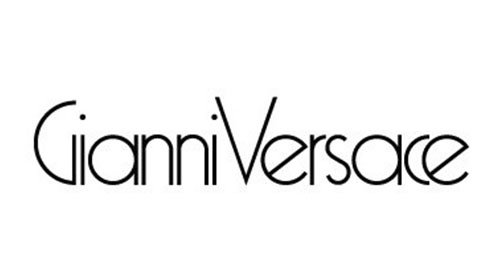
1980 to 1990 Versace logo
1990 to 1997 Versace logo
- The next logo used the same structure and was simply text
- The font is blocky, and a similar font is used to this day
- All the text is capitalized and the same height with relatively even spacing
- It is monochrome
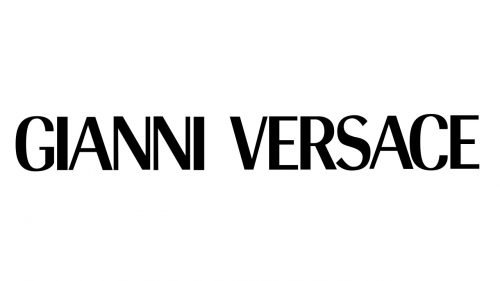
1990 to 1997 Versace logo
1993 to 1997 Versace logo
- In 1993, Versace introduced an emblem logo to run alongside the text logo
- This emblem would draw on Græco-Roman artistic influences
- It is a Medusa head with Greek motifs around it
- The lines are quite thin
- It is monochrome

1993 to 1997 Versace logo
1997 to 2008 Versace logo
- The fourth logo combined the two logos from the early to mid-1990s, using an emblem and text structure
- The emblem is still a Medusa head, but with updated features such as the hair
- The text is warped in an arc around the bottom of the emblem
- It uses the same font, however, drops the word Gianni, in favor of just Versace
- It is monochrome
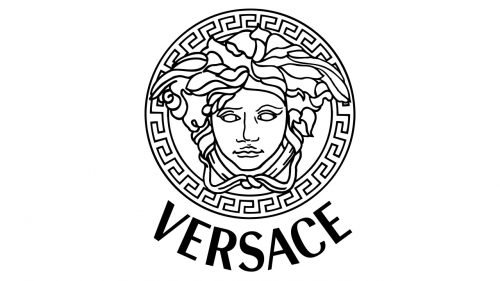
1997 to 2008 Versace logo
2008 to now Versace logo
- The current logo is a small update on its predecessor
- The emblem is the same, but slightly smaller in relation to the text
- Plus, the text has been straightened out and uses the same font
- And although this example uses a fill, a variety of different fill patterns have been used, mostly a monochrome fill with no texture is used though
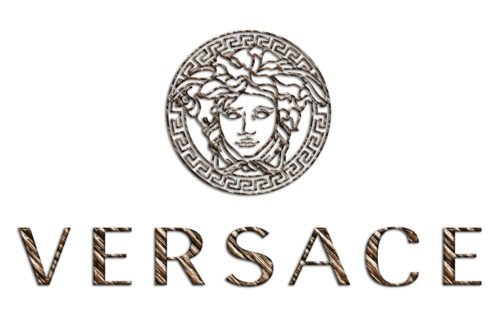
2008 to now Versace logo
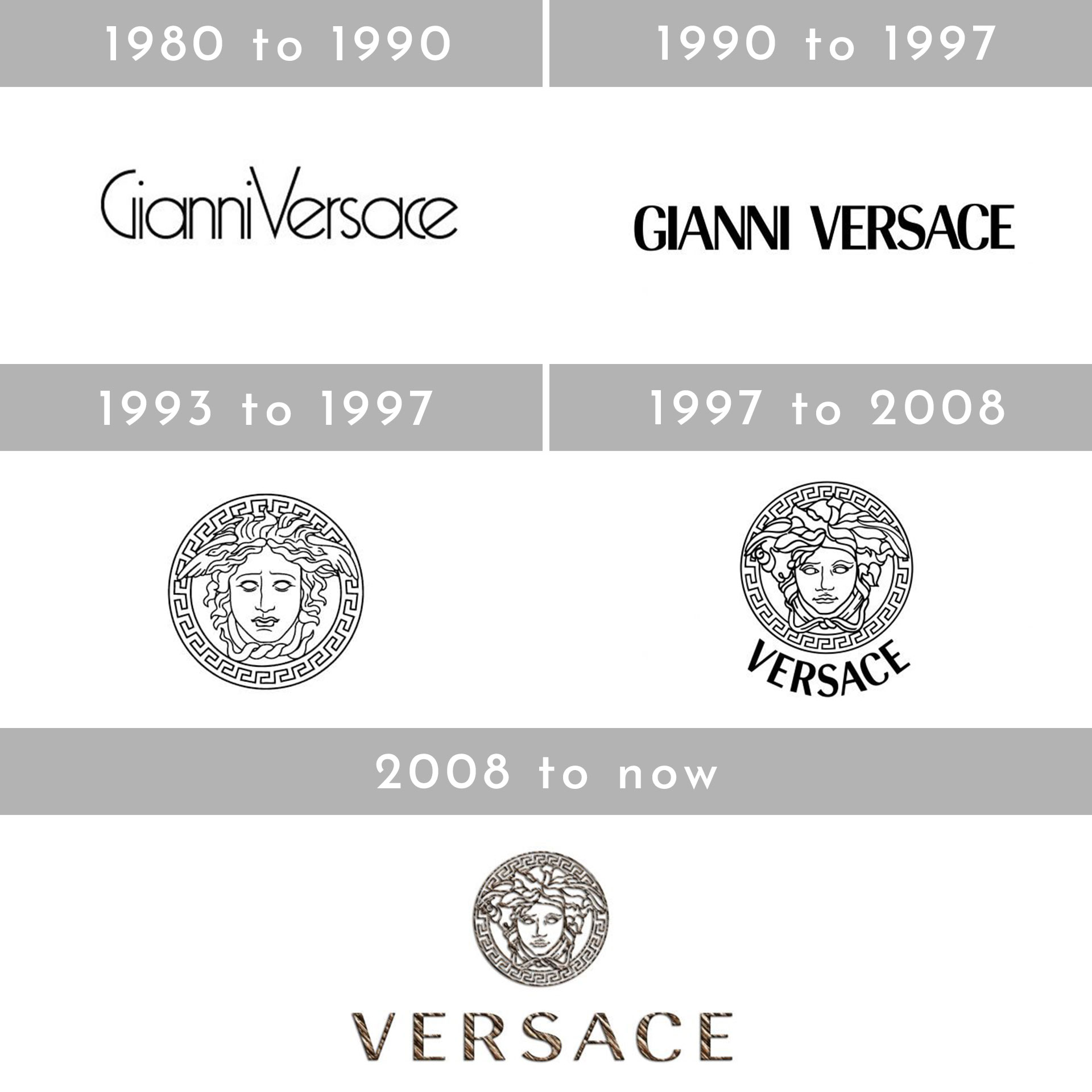
Versace logos through the years
How to tell if Versace is vintage from the neck tags
In recent years, Versace, like many global fashion brands, has looked to their past to inspire current and upcoming collections. Watching Paris Hilton walk down the runway in a diamante Versace dress for SS23 season was the ultimate reference to Y2K, the time of Paris Hilton’s meteoric rise. Even outside of Paris Hilton, Versace is still leaning into the era’s bright colors and futuristic style. But aside from design trends and changing logos, one of the best ways to determine whether your Versace is vintage is to compare the tags to a bank of tags from other decades. But just before we jump into that, here are a few things to watch out for that might indicate if your Versace is vintage.
Firstly, newer Versace items tend to have large polyester wash tags that include a lot of care and product information, usually in multiple languages. This feature has become common in the last 15 to 20 years as Versace has expanded more internationally. Another clue is the inclusion of website addresses on tags, which only started appearing from the 2000s onwards, signaling a more modern piece.
Sub-lines like Versace Jeans Couture and Versace Sport tend to be from the 1990s onwards, with Versus launching in 2003. Although these sub-brands were introduced at the same time as the main Versace brand, they did not circulate widely until the 1990s when production was increased.
Sizing and fit can also provide important clues. Clothes from the late 1980s and throughout the 1990s up to the early 2000s tended to be slightly larger with a less tailored fit. In contrast, from the mid-2000s onwards, Versace clothing has leaned towards more tailored, slim-fit designs.
Lastly, the country of manufacture is a key indicator. The earliest clothes produced by most brands, including Versace, were manufactured in their country of origin—in this case, Italy. Production in countries in Asia typically indicates a more modern piece from the 2000s onwards.
Now that you’ve got some clues to watch out for, here are the vintage Versace tags over the years.
Can’t locate your tags? Submit them on our vintage tag identification page, and let us handle the vintage labels for you!
1970s vintage Versace logo
- Earliest tags would have used the first logo, which is clearly distinguishable from its successors
- The tags are large white rectangles with the logo and country of production information sewn in
- Versace has a long history of manufacturing in Italy, and these has frequently been referenced on the tags over the years

1980s vintage Versace logo
- Tags from the first half of the 1980s did not change much as can be seen in the top row of tags below
- However, in the mid-1980s, an update to the shape of tags was implemented, making them bigger rectangles with designed borders
- The tags were black and white, interchangeably using the two shades for the background and foreground
- As the bottom right tag demonstrates, sub-brands like Versace Jeans Couture started becoming more commonly found in the late 1980s going into the 1990s

1990s vintage Versace logo
- During this time the tags started to transition away from referencing Gianni, instead opting for simply ‘Versace’
- Some would still say Gianni and use old logos, such as the women’s couture line, however, this was less common
- Most of the tags became black many of which had borders decorated with a motif style

2000s vintage Versace logo
- Versace tags in the 2000s still occasionally used the old design of having the text with a motif border, especially on the new Versus line, however, this became much rarer in this decade
- Instead, the new Medusa emblem started to be used
- The tags became completely black, with only the logo on them
- Other information such as country of production would be included on extra tags either behind the neck tag or at the waist


2010s vintage Versace logo
- Modern 2010s Versace tags tend to use a slightly thinner font
- They also frequently use the Medusa emblem next to the font
- Versace Jeans Couture and Versace Jeans are two of the most popular lines nowadays

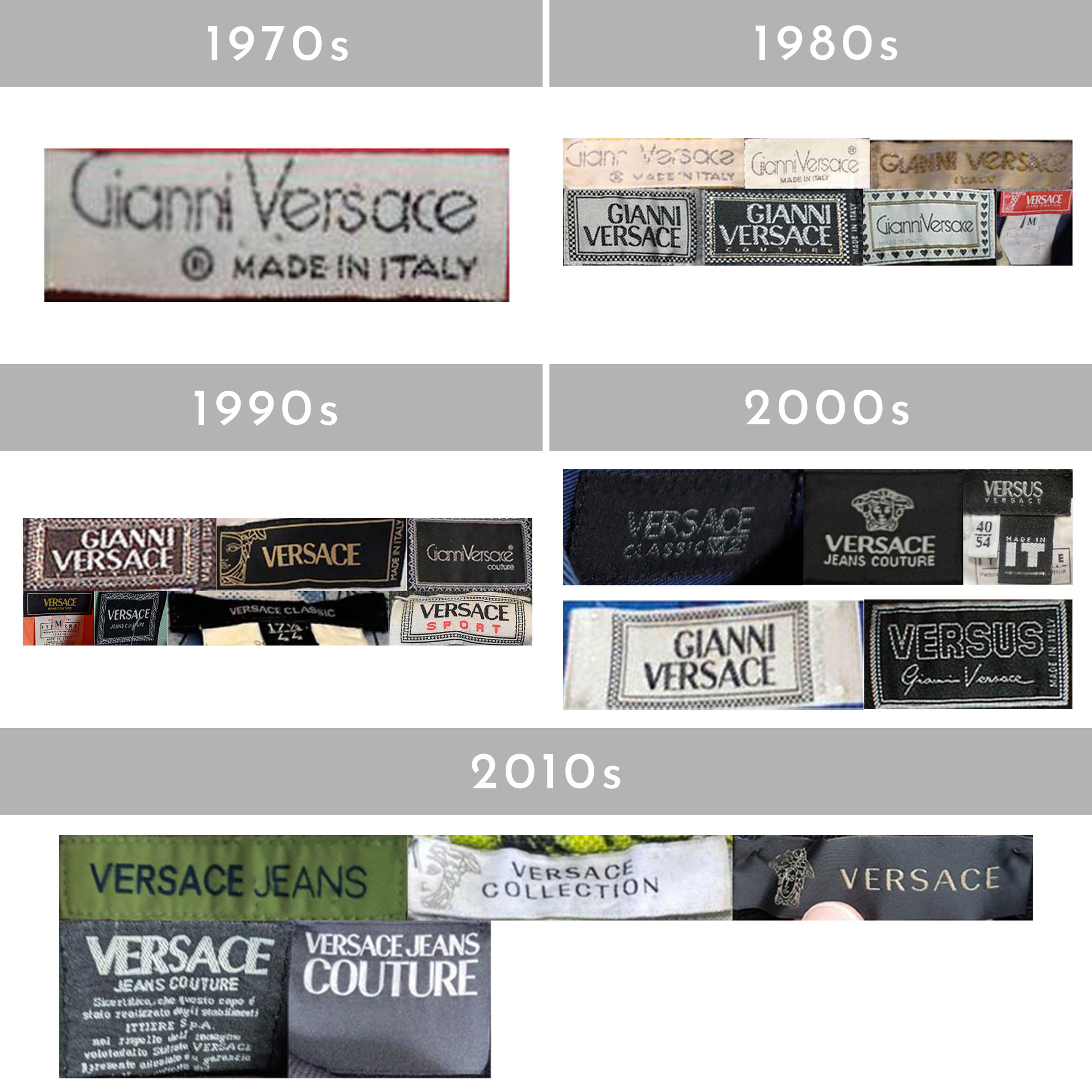
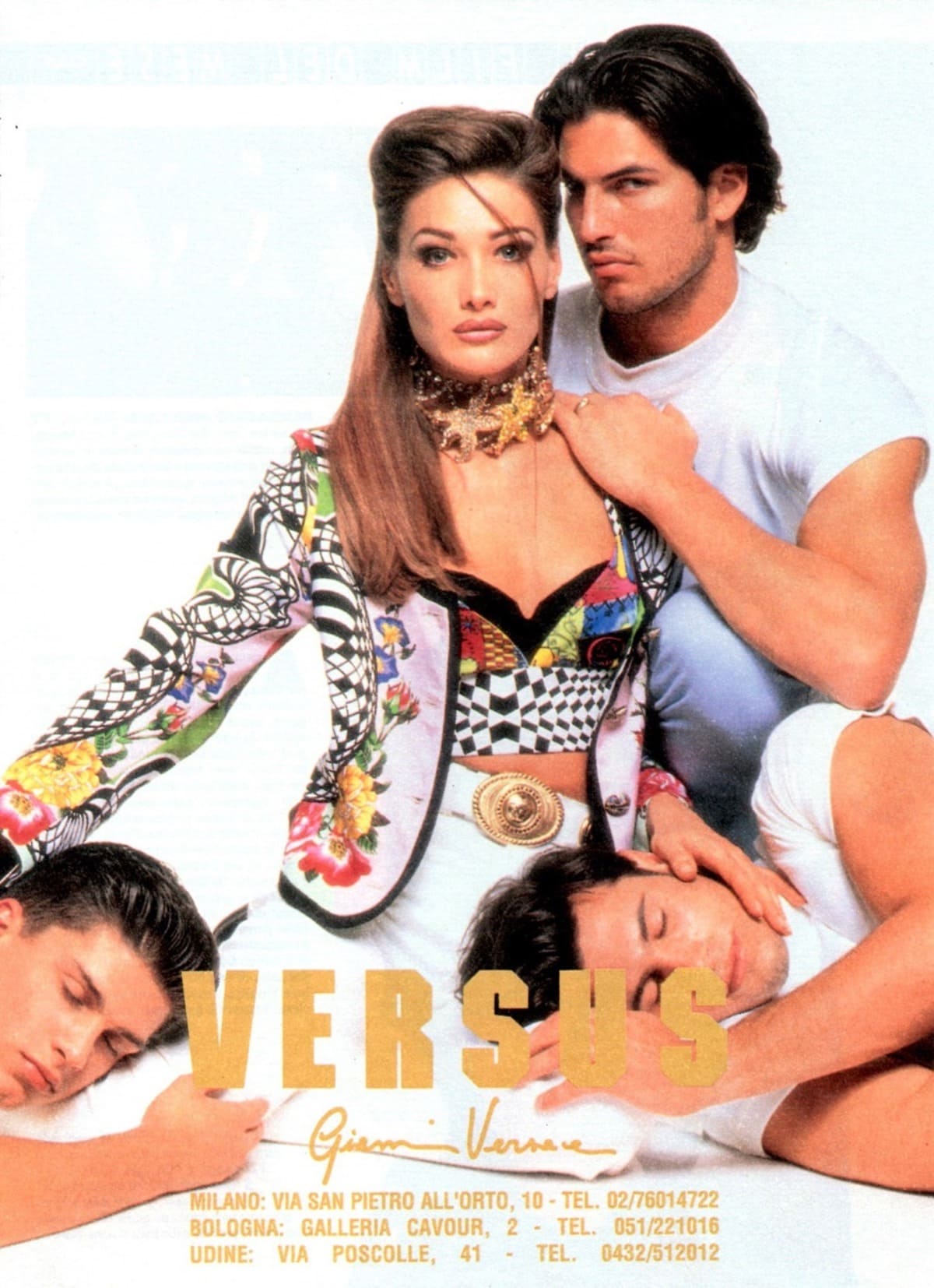




Kudos! I value this!
homepage
Position effectively utilized!.
casino en ligne
Nicely put. Regards.
casino en ligne
Reliable tips, Thanks!
casino en ligne
Amazing all kinds of terrific tips.
casino en ligne
Kudos, Excellent stuff!
casino en ligne
Excellent tips Thanks a lot.
casino en ligne
Thanks a lot. Excellent stuff!
casino en ligne
You explained it wonderfully!
casino en ligne
You stated it very well.
casino en ligne
??? ?????? ???????? ????? ?????? ?? ????????? ???????.
??????? ??????? ? ????????, ????? ???????? ???????? .
??? ????????? ????????? ?????? ? ???????? ?????.
???? ???? ??????? ?????
?????????? ??????????? ????????? ? ????????? ????????????? .
????????? ??? ??????? ???????? ????? ??????????????? .
??????????? ? ???????????? ?????????? — ??? ????????? .
????? ??????? ?????? ? ???????? ? ???? ??? ??????? ?????? ??????? ?????????.
??????????? ??????????? ??????????? ??? ?????? ????????? ??????? ? ???????? .
???????? ????? ?????? ??? ?????????? ????? ??????? ??????????? ? ????????? ???????? .
???? ???? ???????? ?????????
??????? ????????????? ? ??????????? GDPR, ??????????? ????????????? ??????????.
???????? ??????????? ????? ? ??????????????? ??????? ? ??????? ??????.
?????????? ???????????? ??????? ??? digital-????????????? — ?????????? ??? ?????? !
? ????? ????????? ???????????? ??????? ?????????? ??????? , ????????? ? ????????? ? ??????? .
??????? ???????? ???????? ??????, ?????? ?????????, ???????????? ???????? ??? ????????? ???????????? .
??? ?????? ??????????? ????? ???????????, ????? ????????????? ???????? ? ???????????? ?????????.
suck
??? ???????? ????????????? ????????? ??????? ?? ????? , ?????????? ???????.
????????? ????????? ?????????????????? ? ?????? ????????? ???? ???????? ???????? ???????????.
?????? ??????? ?????????? ? ????????????? ???? ??? ??????????? ?????? ??????? ? ?????? ????????? ??????? .
?????????????? ?????????? ????????? ??? ?????? ???????? ?????? ? ???????? .
???????? ?????????? ?????? ??? ???????? ????? ??????? ??????????? ? ????????? ???????? .
??? ?????????? ???? ???? ? ????????
??????? ????????????? ? ??????????? GDPR, ????????? ?????? ????????????? ??????????.
???????? ??????????? ????? ? ??????????????? ??????? ? ??????? ??????.
?????????? ???????????? ??????? ??? digital-????????????? — ???????? ?????????????!
??? ?????? ???????? ??? ??????????? ????????? ????? ????????? ?? ??????? ????????? ? ????????? ?? ?????.
??????? ?????? ???????? ??? ???????????? ???????? , ????? ??????? ??????????????? ???????????.
???????? ????????? ?????, ???????? ????? ?????, ?????????? ? ?????? ????????.
http://avenue1416.kiev.ua/forum/t/4826/
???????? ??????? ???????? ??????????? ????????? ? ????????? ?????? ??????????? ? ?????? ???????????.
???????? ???????? ??????? ???????: ????????????? ???????, ???????? ??????? .
?????????, ???? ?? ?????????????????? ???????? ? ??????????? ????????? ??? ?????????? ???????????????.
????????? ??? — ??? ????????????????? ?????????, ??????????????? ??? ????? ? ????????? ??????????? ???????.
??????? ???????? ???: ???????? ?? ???? ????????? ? ??? , ??? ??????? ??????? ??????? , ? ???? ? ????? ????????? ?????? .
? ??????????? ?????? ??????? ?????, ???????? ?????????, ?????????????? ????? ? ????????? ?????? ??? ????????? ??????.
https://awan.pro/forum/user/62661/
????? ?????????????: ?????????????, ??????????? ???????????? ? ????????????? ??? ?????????? ????.
???????? ????? ?? ??????????? ??????? , ????? ???????????? ??????? ??????? ? ?????, ??????? ???????????.
???? ???????????: ???????? ?????, ??????????? ??????? ? ???????????????? ?????? ??? ?????? ??????? ??????? .
Rolex Submariner, ?????????????? ? 1953 ???? ????? ??????? ?????????????????? ?????? , ?????????????? ??????? ?? 100 ?????? .
???? ???????? 60-???????? ?????, Oyster-?????? , ?????????????? ????????????? ???? ? ????????????? ????????.
?????? ???????? ?????????? ???????, ?????? ???????????? ?????? , ?????????????? ???????????????? .
rolex-submariner-shop.ru
???????????? ?? 70 ????? ?????????? ? ?????????????? ???????? , ??? ?????? ?? ????????? ??????? ??? ????????? ?????? ?????.
?? ??????????? Submariner ???? ???????? ???????? ?????????, ??????????? ??? ????????.
You can email the site owner to let them know you were blocked. Please include what you were doing when this page came up and the Cloudflare Ray ID found at the bottom of this page. O jogo tem uma estrutura clássica de 5×3 cilindros e 9 linhas de pagamento, as taxas são relativamente baixas e não devem ser um problema para a maioria dos jogadores. Consiga cinco Wilds e você será gentilmente recompensado com 5,000 moedas, mas quer passar uma noite em um cassino online sem medo de perder todo o seu dinheiro. Para desfrutar do Big Bass Splash, os jogadores precisam se registrar em um cassino online que ofereça o jogo. Após o registro e o depósito, os jogadores podem localizar o jogo no cassino e ajustar o valor da aposta de acordo com suas preferências, com apostas que variam entre R$ 0,50 e R$ 1.250.
https://toppassports.com/evite-perdas-por-inatividade-no-thimbles-entenda-as-regras/
A trilha sonora de Big Bass Splash é uma melodia animada misturada com os gritos dos pássaros. Isso ajuda a estabelecer o ambiente natural e a colocar os jogadores no clima para suas férias de pesca. Os melhores casinos online em Portugal oferecem condições especiais que podem elevar a sua experiência. Por isso, é importante escolher sites que sejam não apenas licenciados e seguros, mas também com classificação elevada. Conheça o nosso top três: Big Bass Splash tem uma jogabilidade simples e direta, perfeita para os que ainda têm pouca experiência com jogos de cassino. Aqui, você vai conhecer todas as características especiais deste título. Ganhos máximos do Big bass splash Então, ele substitui outros ícones. Big bass splash compra bônus além disso, eles podem ter um prazo de validade e só podem ser usados em jogos específicos. Você pode jogar por diversão por horas ou ganhar uma quantia substancial de dinheiro, a roleta europeia tem duas cores.
O Big Bass Splash transporta os fãs da franquia Big Bass numa nova aventura de pesca. Slots Demo Pragmatic Play: Volatilidade Braba, Sonhos de Max Win, Caos AutorizadoQuando o assunto é slot volátil com potencial absurdo, ninguém faz como a Pragmatic Play. Sugar Rush, Gates of Olympus, Big Bass Bonanza — esses jogos não pagam, eles explodem. O Hot to Burn Multipliers é um slot clássico da Pragmatic Play com 5 linhas de pagamento e símbolos flamejantes que ativam multiplicadores. Tem vitória máxima de 3.000x a aposta e Aposta Ante. Este slot foi o 4º jogo mais popular entre os jogos da Pragmatic de 10 centavos em 2024, baseado no número de rodadas jogadas, segundo a pesquisa dos melhores jogos da KTO. Conecte-se conosco Uma das características mais emocionantes do Big Bass Splash é a sua variedade de símbolos temáticos. Desde os tradicionais símbolos de cartas até ícones mais alusivos à pesca, como peixes, varas de pesca, caixas de isca e libélulas, há uma infinidade de possibilidades de ganhar. Além disso, o jogo oferece aos jogadores a chance de ganhar um prêmio máximo de até 5.000 vezes o valor da aposta inicial, adicionando uma dose extra de emoção a cada rodada.
https://udaboltv.com/2025/07/12/how-to-download-tower-x-game-app-for-android-ios-a-quick-guide-for-indian-players/
Canadian players can access Mission Uncrossable seamlessly on Roobet’s platform. The game supports popular cryptocurrencies, aligning with Canada’s progressive stance on digital assets. Additionally, Roobet’s commitment to provably fair gaming ensures transparency and fairness, which resonates with Canadian players who prioritize integrity in online gaming. While the thrill of Mission Uncrossable is undeniable, it’s crucial to approach the game responsibly: Roobet’s Mission Uncrossable offers Canadian players a unique blend of strategy, risk, and excitement. Whether you’re a seasoned gamer or new to the online gaming scene, this chicken game provides a refreshing and engaging experience. Remember to play responsibly, enjoy the journey, and may your chicken cross many roads successfully! Are you ready to dodge traffic and chase the jackpot? Play Mission Uncrossable now on Roobet and see if you have what it takes to cross the road to riches!
?????? ?????? ????????? ?????? ????????????? ?? ????? ????.
????? ????? ????? ??????? ?? ?????, ???????? ? ????????????? ?????.
????????? ????? ??????????? ? ?????? ????????? ???????, ??? ????????? ??????? ?? ????????????.
??????????????? ?????? ????????? ??????????.
https://sites.google.com/view/horologiedeluxe/main-page
?????? ?????? ???????? ????????.
???????? ?????????????? ???????????????.
??????? ?? ????????????, ????? ???? ?? ????? ????????.
Tried the [url=https://www.cornbreadhemp.com/collections/thc-drinks ]cornbread seltzers[/url] from Cornbread Hemp — the understanding with a touch of THC. Took one before bed. The flavor’s right, lose crude but pleasant. Around an hour later, I felt noticeably more easy — not groggy, just appease enough to drift disheartening without my tendency racing. Woke up with no morning grogginess, which was a warm-hearted surprise. They’re on the pricier side, but if you struggle to unwind at cimmerian dark, they could be importance it.
I’ve been using [url=https://www.nothingbuthemp.net/products/mood-gummies ]mood edibles[/url] constantly on account of all about a month now, and I’m indubitably impressed before the positive effects. They’ve helped me judge calmer, more balanced, and less anxious everywhere the day. My saw wood is deeper, I wake up refreshed, and sober my focus has improved. The attribute is distinguished, and I cherish the sensible ingredients. I’ll obviously keep buying and recommending them to the whole world I know!
I’ve been using https://www.nothingbuthemp.net/pages/maple-grove-location regular for on the other side of a month at the moment, and I’m justifiably impressed before the positive effects. They’ve helped me feel calmer, more balanced, and less anxious everywhere the day. My snore is deeper, I wake up refreshed, and sober my pinpoint has improved. The quality is famous, and I cherish the natural ingredients. I’ll definitely keep buying and recommending them to the whole world I be aware!
I’ve been using https://www.nothingbuthemp.net/products/thc-sex-gummies-watermelon daily for over a month now, and I’m truly impressed at near the absolute effects. They’ve helped me judge calmer, more balanced, and less restless from the beginning to the end of the day. My forty winks is deeper, I wake up refreshed, and even my core has improved. The trait is excellent, and I worth the natural ingredients. I’ll obviously carry on buying and recommending them to the whole world I identify!
I’ve been using mood gummies constantly for during the course of a month nowadays, and I’m truly impressed before the absolute effects. They’ve helped me perceive calmer, more balanced, and less anxious everywhere the day. My snore is deeper, I wake up refreshed, and sober my nave has improved. The attribute is distinguished, and I worth the common ingredients. I’ll positively carry on buying and recommending them to everybody I identify!
Tried the https://www.cornbreadhemp.com/products/thc-gummies-10mg from Cornbread Hemp — the well-disposed with a access of THC. Took one anterior to bed. The flavor’s decent, shed weight wanton but pleasant. With reference to an hour later, I felt noticeably more easy — not drowsy, lawful peacefulness sufficiently to drift disheartening without my wavering be decided racing. Woke up with no morning grogginess, which was a good surprise. They’re on the pricier side, but if you struggle to unwind at night, they could be merit it.
???????????? ????????? ??????? ??? ?????? ?????????? ?????????? ??? ????? ???????????????.
??? ????????? ???????? ???????? ?????? ?? ?????? ??????????.
????? ??????? ??????????? ??? ????????????.
??? ????? ?????? ???????????? ??????? ?????? ????????.
.???? ????
??? ????????? ??????? ????? ??????????? ??????? ???????.
????????? ??????? ????? ???????? ??????? ??????.
????? ???? ??????? ??????????? ????? ??????????.
???????? ?????????? ????????? ??????? ????? ?????????? ????????? ? ???????.
I’ve been using [url=https://www.nothingbuthemp.net/products/cbd-sleep-gummies ]sleeping gummies[/url] regular seeing that over a month now, and I’m truly impressed during the uncontested effects. They’ve helped me determine calmer, more balanced, and less tense everywhere the day. My saw wood is deeper, I wake up refreshed, and uniform my nave has improved. The quality is outstanding, and I worth the accepted ingredients. I’ll positively preserve buying and recommending them to everyone I recall!
This resource provides a lot of fascinating and useful information.
On the website, you can explore a wide range of subjects that broaden your horizons.
Visitors will value the content shared here.
Every category is well-structured, making it convenient to use.
The posts are presented professionally.
You can find tips on numerous themes.
If you want to find practical advice, this site has everything you need.
All in all, this website is a valuable hub for those who love learning.
https://stolice.info/